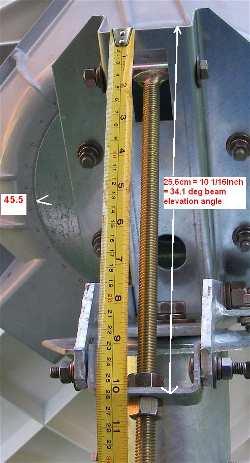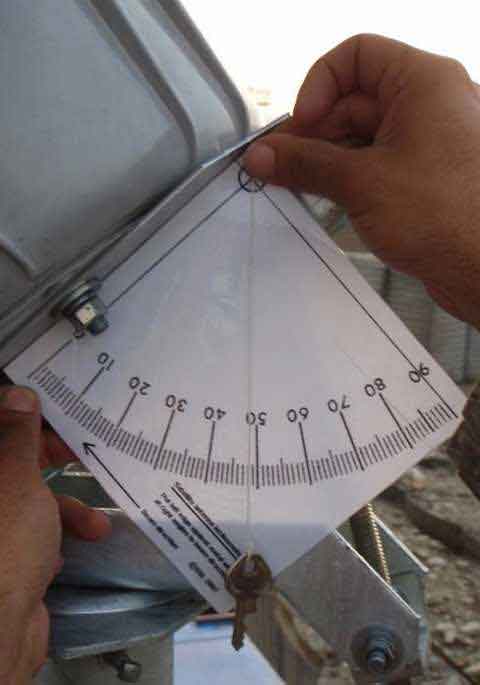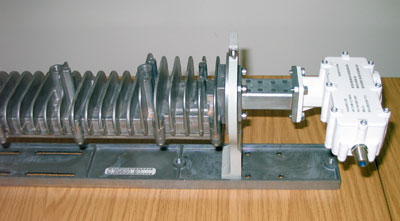Post by Eric Johnston on Feb 24th, 2011 at 7:40am
Assuming you have the 1.2m Prodelin dish with giant circular polarisation scale on the back and feed horn throat with 505 on it and Hughes universal LNB/OMT ....
For 29 deg beam elevation set the distance to 28 cm.
see https://www.satsig.net/bentley-walker/hx/setting-elevation-angle-prodelin-1point2m.htm
This will work only if you have the base level and the big hold down bolt tight enough to allow azimuth movement but not enough to allow the dish to sag down. The same applies to the four polarisation bolts. If there is some sagging down aim higher up with say 27.6 cm.
If you have an inclinometer apply it to the polarisation plate (rear surface of the wedge shaped plastic box).
You can make your own inclinometer like this by printing out page https://www.satsig.net/pointing/how-to-make-inclinometer.htm You need to set 29.5 deg, not the 48 deg, as shown in the picture.
Once you have set the elevation accurately swing the dish boldly sideways and stop when you find the satellite. The modem receive signal power will increase.
If you can only get a max of 29 then your configuration needs attention, wrong polarisation or wrong satellite.
If your wanted receive polarisation name is horizontal and you have universal LNB then start by turning the dish so that the LNB connector is sideways. It is likely that you assembled it like this.
If your wanted receive polarisation name is vertical, turn the dish so that universal LNB connector is up or down.
See pictures https://www.satsig.net/bentley-walker/hughes-hx-vsat-universal-lnb.htm
The 505 on the feed throat must be directly away from the feed support arm.
Best regards, Eric
For 29 deg beam elevation set the distance to 28 cm.
see https://www.satsig.net/bentley-walker/hx/setting-elevation-angle-prodelin-1point2m.htm
This will work only if you have the base level and the big hold down bolt tight enough to allow azimuth movement but not enough to allow the dish to sag down. The same applies to the four polarisation bolts. If there is some sagging down aim higher up with say 27.6 cm.
If you have an inclinometer apply it to the polarisation plate (rear surface of the wedge shaped plastic box).
You can make your own inclinometer like this by printing out page https://www.satsig.net/pointing/how-to-make-inclinometer.htm You need to set 29.5 deg, not the 48 deg, as shown in the picture.
Once you have set the elevation accurately swing the dish boldly sideways and stop when you find the satellite. The modem receive signal power will increase.
If you can only get a max of 29 then your configuration needs attention, wrong polarisation or wrong satellite.
If your wanted receive polarisation name is horizontal and you have universal LNB then start by turning the dish so that the LNB connector is sideways. It is likely that you assembled it like this.
If your wanted receive polarisation name is vertical, turn the dish so that universal LNB connector is up or down.
See pictures https://www.satsig.net/bentley-walker/hughes-hx-vsat-universal-lnb.htm
The 505 on the feed throat must be directly away from the feed support arm.
Best regards, Eric


